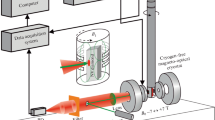Abstract
Several new radiation defects with total electron spin S = 1 occurring in electron-irradiated, synthetic α-quartz have been observed by using electron paramagnetic resonance spectroscopy. These defects are considered to be biradicals, i.e., pairs of S = 1/2 species. The concentration of these centers depends on the condition of the fast-electron irradiation. They have different decay behaviors that allow measurements of any individual species especially when it predominates over the others. The primary spin Hamiltonian parameter matrices g 1, g 2, D have now been determined for two similar defects, which herein are labeled \( E_{2}^{\prime \prime } \) and \( E_{4}^{\prime \prime } \). Inter-electron distances estimated by using the magnetic dipole model, suggest that the structures of centers \( E_{2}^{\prime \prime } \) and \( E_{4}^{\prime \prime } \) both involve the unpaired electrons each located in orbitals of two silicon atoms next to a common oxygen vacancy but which have slightly different Si–Si distances at 0.90 and 0.79 nm, respectively. This model is consistent with previous DFT calculations of the triplet configurations with local energetic minima. Observed decay behaviors suggest a transformation of centers \( E_{2,4}^{\prime \prime } \) to the analogous \( E_{1}^{\prime \prime } \) center. These triplet centers in quartz provide new insights into the structures of analogous defects in amorphous silica.





Similar content being viewed by others
References
Abragam A, Bleaney B (1970) Electron paramagnetic resonance of transition ions. Clarendon, Oxford
Boero M, Oshiyama A, Silvestrelli PL (2004) E′ centers in silicon dioxide: first-principles molecular dynamics studies. Mod Phys Lett B 18:707–724
Bossoli RB, Jani MG, Halliburton LE (1982) Radiation-induced E″ centers in crystalline SiO2. Solid State Commun 44:213–217
Buscarino G, Agnello S, Gelardi FM (2006) Characterization of Eδ′ and triplet point defects in oxygen-deficient amorphous silicon dioxide. Phys Rev B 73:045208.1–045208.8
Carbonaro CM, Fiorentini V, Bernardini F (2001) Proof of the thermodynamical stability of the E′ center in SiO2. Phys Rev Lett 86:3064–3067
Griscom DL, Friebele EJ (1986) Fundamental radiation-induced defect centers in synthetic fused silicas: atomic chlorine, delocalized E′ centers, and a triplet state. Phys Rev B 34:7524–7533
Lægsgaard J (2002) Triplet states at an O vacancy in α-quartz. Phys Rev B 66:024107.1–024107.9
Mashkovtsev RI, Howarth DF, Weil JA (2007) Biradical states of oxygen-vacancy defects in α-quartz. Phys Rev B 76:214114.1–214114.11
Mombourquette MJ, Weil JA (2007) EPR-NMR users’ manual. Version 6.5.3. Department of Chemistry, University of Saskatchewan, Saskatoon
Nilges MJ, Pan Y, Mashkovtsev RI (2008) Radiation-induced defects in quartz. I. Single-crystal W-band EPR study of an electron-irradiated quartz. Phys Chem Min 35:103–115
Nilges MJ, Pan Y, Mashkovtsev RI (2009) Radiation-induced defects in quartz. III. Single-crystal EPR, ENDOR and ESEEM study of a peroxy radical. Phys Chem Min 36:61–73
Pan Y, Hu B (2009) Radiation-induced defects in quartz. IV. Thermal stabilities and implications. Phys Chem Min 36:421–430
Pan Y, Nilges MJ, Mashkovtsev RI (2008) Radiation-induced defects in quartz. II. W-band single-crystal EPR study of a natural citrine. Phys Chem Min 35:387–397
Pan Y, Nilges MJ, Mashkovtsev RI (2009) Radiation-induced defects in quartz: multifrequency EPR study and DFT modeling of new peroxy radicals. Min Mag 73:519–535
Pantelides ST, Lu ZY, Nicklaw C, Bakos T, Rashkeev SN, Fleetwood DM, Schrimpf RD (2008) The E′ center and oxygen vacancies in SiO2. J Non Cryst Solids 354:217–223
Perlson BD, Weil JA (2008) Electron paramagnetic resonance studies of the E′ centers in alpha-quartz. Can J Phys 86:871–881
Skuja L, Kajihara K, Hirano M, Saitoh A, Hosono H (2006) An increased F2-laser damage in ‘wet’ silica glass due to atomic hydrogen: a new hydrogen-related E′-center. J Non Cryst Solids 352:2297–2302
Skuja L, Kajihara K, Hirano M, Saitoh A, Hosono H (2008) Hydrogen-related radiation defects in SiO2-based glasses. Nucl Instrum Methods Phys Res B 266:2971–2975
Solntsev VP, Mashkovtsev RI, Shcherbakova MY (1977) Electron paramagnetic resonance of the radiation centers in quartz. J Struct Chem 18:578–583
Sonder E, Sibley WA (1972) Defect creation by radiation in polar crystals. In: Crawford JH, Slifkin LN (eds) Point defects in solids. Plenum, New York, pp 117–131
Tohmon R, Shimogaichi Y, Tsuta Y, Munekuni S, Ohki Y, Hama Y, Nagasawa K (1990) Triplet-state defect in high-purity silica glass. Phys Rev B 41:7258–7260
Weeks RA, Abraham M (1965) Spin-one states of defects in quartz. Bull Am Phys Soc 10:374
Weeks RA, Magruder RH, Stesmans A (2008) Review of some experiments in the 50 year saga of the E′ center and suggestions for future research. J Non Cryst Solids 354:208–216
Weil JA (1984) A review of electron spin resonance and its applications to the study of paramagnetic defects in crystalline quartz. Phys Chem Min 10:149–165
Weil JA (1993) A review of the EPR spectroscopy of the point defects in alpha-quartz: the decade 1982–1992. In: Helms CR, Deal BE (eds) The physics and chemistry of SiO2 and the Si–SiO2 interface, vol 2. Pergamon, New York, pp 131–144
Weil JA (2000) A demi-century of magnetic defects in α-quartz. In: Pacchioni G, Skuja L, Griscom DL (eds) Defects in SiO2 and related dielectrics: science and technology. Kluwer, Dordrecht, pp 197–212
Weil JA, Bolton JR (2007) Electron paramagnetic resonance, 2nd edn. Wiley, New York
Zhang L, Leisure RG (1996) The Eδ′ and triplet-state centers in x-irradiated high-purity amorphous SiO2. J Appl Phys 80:3744–3749
Acknowledgments
R.I.M. acknowledges support from the Russian Foundation for Basic Research (Grant 10-05-00178). The authors would like to thank Prof. M. Rieder and two anonymous reviewers for constructive comments and helpful suggestions, and the late Prof. J. A. Weil for helpful discussions during the early stages of this study.
Author information
Authors and Affiliations
Corresponding author
Rights and permissions
About this article
Cite this article
Mashkovtsev, R.I., Pan, Y. Biradical states of oxygen-vacancy defects in α-quartz: centers \( E_{2}^{\prime \prime } \) and \( E_{4}^{\prime \prime } \) . Phys Chem Minerals 38, 647–654 (2011). https://doi.org/10.1007/s00269-011-0437-0
Received:
Accepted:
Published:
Issue Date:
DOI: https://doi.org/10.1007/s00269-011-0437-0




